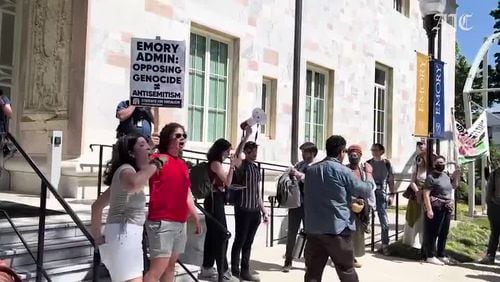RICHMOND, Va. — After years of resistance and a long court battle, one of America’s largest monuments to the Confederacy was pulled from its prominent perch in Virginia’s capital city Wednesday.
»Watch a replay of the statue’s removal
Virginia Gov. Ralph Northam ordered the Richmond statue of Gen. Robert E. Lee taken down last summer, citing the pain felt across the country over the death of George Floyd in Minneapolis after a white police officer pressed a knee into his neck. But until a recent court ruling cleared the way, Northam’s plans had been tied up in litigation.
The statue, a 21-foot bronze equestrian sculpture that sat atop a pedestal nearly twice that tall, had towered above a prominent residential boulevard named Monument Avenue since 1890 in this former capital of the Confederacy.
Crews began work before 8 a.m. Wednesday. Two public viewing areas were set up, with only limited visibility. Crowds chanted “What do we want? Justice. When do we want it? Now!” as a work crew dwarfed by the size of the statue strapped red and blue harnesses to the Lee figure and his horse. The workers were lifted up to the statue on platforms.
The state brought in a deconstruction crew surrounded by a heavy police presence to strap the statue to a crane. State, Capitol and city police officers closed streets for blocks around the state-owned traffic circle in Richmond, using heavy equipment and crowd-control barriers to keep crowds away. Visibility was limited from public viewing areas and the Federal Aviation Administration granted the state’s request to ban drone flights during the event, which was being livestreamed through the governor’s Facebook and Twitter accounts.
The one-of-a-kind piece, valued for its artistic quality, stood among four other massive Confederate statues on the avenue, but the city removed the others last summer.
“We put things on pedestals when we want people to look up,” Northam said in June 2020 when he announced the removal plan. “Think about the message that this sends to people coming from around the world to visit the capital city of one of the largest states in our country. Or to young children.”
The statue’s removal was expected to be completed Wednesday. Plans called for it to be cut into at least two pieces and hauled to an undisclosed state-owned facility until a decision is made about its final disposition. The pedestal is to remain for now, although workers are expected to remove decorative plaques and extricate a time capsule Thursday.
After Floyd’s death, the area around the statue became a hub for protests and occasional clashes between police and demonstrators. The pedestal has been covered by constantly evolving, colorful graffiti, with many of the hand-painted messages denouncing police and demanding an end to systemic racism and inequality.
The decisions by the governor and Richmond Mayor Levar Stoney to remove the Confederate tributes marked a major victory for civil rights activists, whose previous calls over the decades to remove the statues had been steadfastly rebuked by city and state officials alike.
A previous wave of resistance to the statues came in 2017, when a rally of white supremacists in the city of Charlottesville erupted into violence. Other Confederate monuments started falling around the country.
But in Virginia, local governments were hamstrung by a state law that protected memorials to war veterans. That law was amended in 2020 by the new Democratic majority at the statehouse and signed by Northam. With the changes that took effect on July 1, 2020, localities could decide the monuments’ fate.
Stoney then moved swiftly, citing the continuing demonstrations and concerns that protesters could get hurt if they tried to bring down the enormous statues themselves.
The Lee statue was created by the internationally renowned French sculptor Marius-Jean-Antonin Mercie and is considered a “masterpiece,” according to its nomination to the National Register of Historic Places, where it has been listed since 2007.
When the statue arrived in 1890 from France, an estimated 10,000 Virginians used wagons to haul its pieces more than a mile to where it now stands. White residents celebrated the statue, but many Black residents have long seen it as a monument glorifying slavery.
The Northam administration has said it would seek public input on the statue’s future. The 40-foot granite pedestal will be left behind for now amid efforts to rethink the design of Monument Avenue. Some racial justice advocates don’t want it removed, seeing the graffiti-covered pedestal as a symbol of the protest movement that erupted after Floyd’s killing.
Lawrence West, 38, a member of BLM RVA, an activist group that’s been occupying the transformed space at the Lee monument, said he believes the decision to remove the statue was fueled by the work of protesters.
“I mean, it hadn’t come down before. They (Democrats in charge of state government) had all the opportunities in the world.”
West said he would like to see the statue site turned into a community space “to cultivate all types of connections between different people.”





